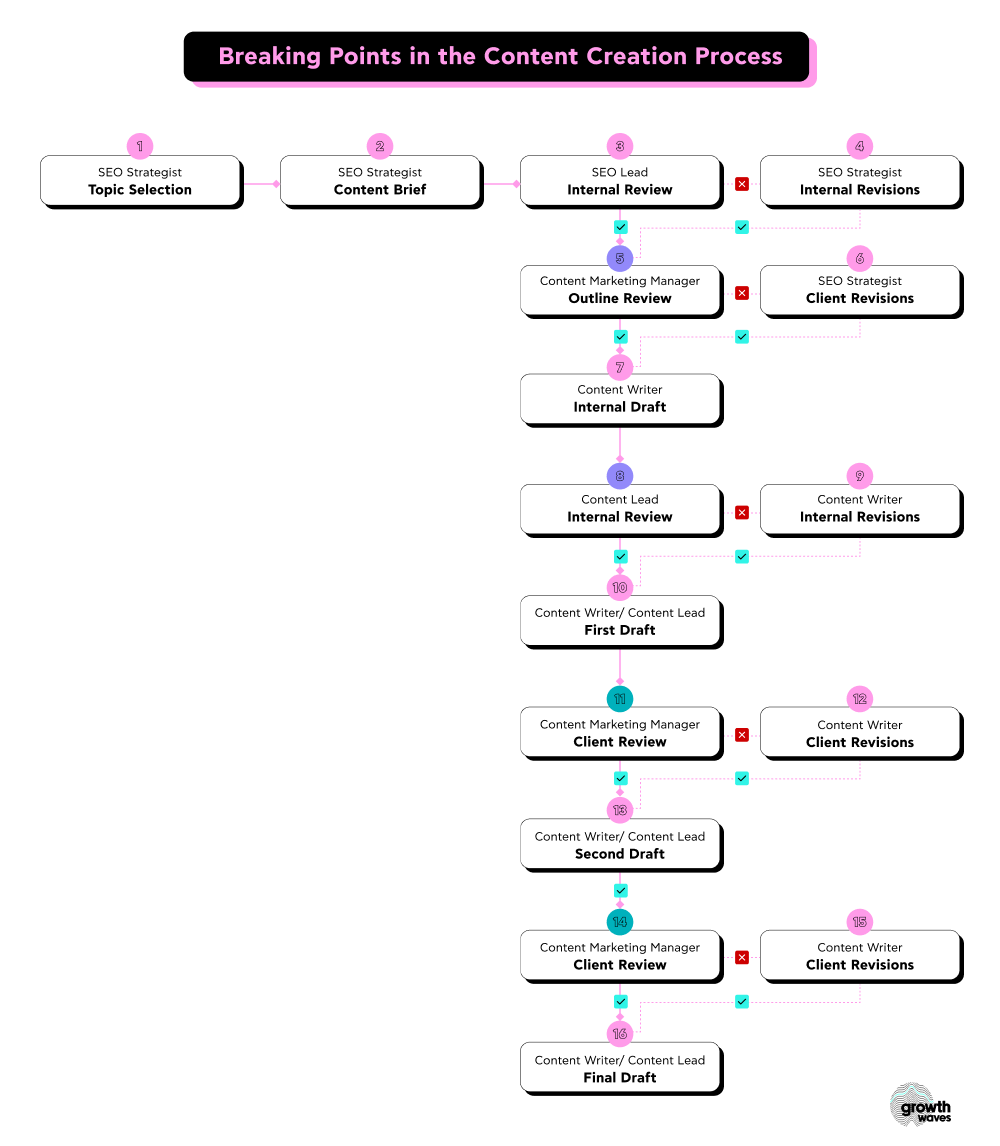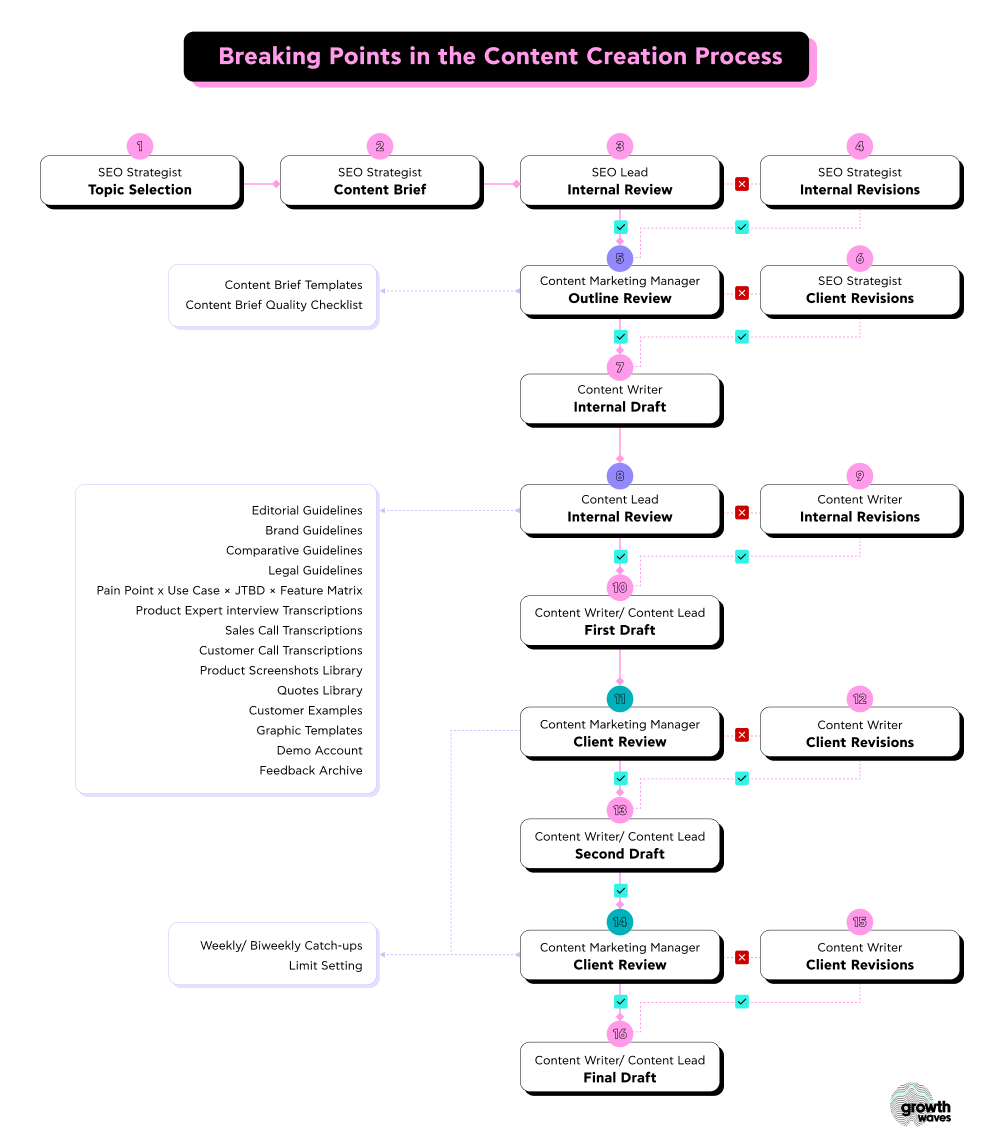The breaking point
Why content processes break—and how to fix them
👋 Hey, I’m George Chasiotis. Welcome to GrowthWaves, your weekly dose of B2B growth insights—featuring powerful case studies, emerging trends, and unconventional strategies you won’t find anywhere else.
When I’m not working on these notes for you, I’m working on running Minuttia.
Minuttia is a growth agency for B2B SaaS companies.
One of our core services is content creation.
Over the years, we’ve developed a robust process that repeatedly works tremendously well for B2B SaaS companies in some of the most competitive and industry-specific SaaS categories.
There’s just one problem with this process.
It occasionally breaks.
When it does, we immediately do two things…
identify the breaking points
develop tactics and methods to fix them
And that’s what today’s note is all about.
Content creation process
Before I begin, I want to share a couple of things that are important to keep in mind:
The process I mentioned works from an agency standpoint; a SaaS company creating content in-house can have a very different process.
The steps and roles involved and the overall naming convention are—once again—our way of doing things. Yours may be different.
The Content Marketing Manager on the client’s side is the person who usually edits our work and collaborates with us on certain parts of the process. I use that job title for the sake of simplicity.
Here’s what the content creation process looks like:
Step 1
As you can see above, everything starts with the SEO Strategist—assuming the piece is going to target a search audience (aka SEO Content)—selecting the topic or validating the topic we’ve been given by our client.
Steps 2–3
Then, the SEO Strategist will work on the Content Brief, which will be reviewed by the SEO Lead, essentially a second pair of (more experienced) eyes to ensure everything is as it should be.
Steps 4-6
If there are any revisions, the SEO Strategist will work on them.
If there are no revisions, the Content Marketing Manager (on the client’s side) will review the Outline, which is one of the parts included in the content brief.
Note: The parts included in a content brief are a) the Content Instructions, b) the Outline, and c) the SEO Information.
Steps 7-10
From there, the Content Writer will work on the Internal Draft, which will be reviewed by the Content Lead on this occasion.
If there are any revisions, the Content Writer will work on them.
If there are no revisions, the Content Writer and Content Lead will finalize the First Draft.
Steps 11-13
The Content Marketing Manager will then review the First Draft and will leave feedback (if any) so the Content Writer can work on the revisions and come up with the Second Draft.
Steps 14-16
The process will repeat itself if there are further revisions required to the Second Draft. This eventually leads to the Final Draft.
As you can imagine, this is a tedious process that has many moving parts, a lot of opinions, and many people, each playing their own role and making their unique contribution to the outcome.
The question is:
Where does this process (usually) break?
The breaking point(s)
Here’s where the content creation process breaks:
Step 5
As you can see above, the first breaking point is the Outline Review from the (client’s) Content Marketing Manager.
There are several reasons why this may be a breaking point.
Two prominent ones are:
The client and our team have a different vision as to the structure of certain types of posts.
There are similarly differing views as to the level of detail for the Outline.
The good thing is that after encountering such an issue (or, to put it better, an opportunity for leveling up our processes) we introduced a few things that reduced the friction significantly.
We’ll see them in a minute.
For now, let’s move on to the next breaking point.
Step 8
The second breaking point in the Internal Review step is where the Content Lead reviews the Internal Draft the Content Writer created.
Once again, there are various reasons why this might happen.
You could argue that some of these reasons come down to the quality of the Content Writers.
That’s a fair point and something that the Content Writers can work on. Very occasionally, it may involve new Content Writers being found.
Again, we’ll see how we try to remove the friction of this step in a minute.
For now, let’s move on to the final two breaking points.
Steps 11 & 14
The two points in the process where we usually see the most friction (occasionally involving difficult conversations!) are the first and second Client Reviews.
Even though they get better over time—assuming there’s goodwill and common objectives on both sides—the early days can be really ugly.
Thankfully, after dealing with several Client Reviews for almost 4 years now, we’ve developed a few safeguards that help speed up the reviewing process so that the content goes live faster without disrupting the quality standards or publishing efficiency of the company.
Of course, and this is very important, we take for granted that there’s goodwill and a shared commitment, regardless of the relationship between the creator and the reviewer.
Note: In our example, there’s a client-agency relationship. Even though every relationship is different, for the most part, the dynamics and interaction between the different stakeholders are similar to any other relationship (e.g., Content Marketing Manager and in-house Content Writer).
Let’s take these breaking points and see what we do nowadays to fix them.
(And, most importantly, how you can fix them too.)
Fixing the breaking point(s)
This is where everything comes to a head.
Processes break all the time.
The question is – how can you fix them?
Here’s how to fix the breaking points of the content creation process we just described:
Step 5
We usually see friction in this step of the process due to the two differences in vision that we mentioned earlier.
We can alleviate those differences by using:
Content Brief Templates: for content formats used often (e.g., alternative list posts for SaaS companies).
Content Brief Quality Checklist: to ensure not only quality but also alignment in terms of the level of detail expected on the client’s side.
Having tried-and-tested content brief templates for different content formats we usually create, helps us speed up the process. It usually eliminates the need for structural changes in the outline during the Outline Review step.
Of course, there’s a certain level of customization that goes into each template for each of our clients, as different companies have different ways of doing things.
However, for the most part, after the initial adjustments—and maybe some refinement as we better understand what works best in each case—there are no big changes to the content brief templates.
The checklist serves as a way to set some safeguards in terms of quality and level of detail, since every individual has their own interpretation of what an outline is and how detailed it should be.
Once again, there’s a level of customization to meet each client’s needs, but for the most part, the checklist is more or less the same for every client.
Step 8
The reason why we have all these helpers in this step and not in any of the Client Review steps (i.e., Steps 11 and 14) is that content needs to be improved internally first before it reaches our client for review.
To improve content quality and ensure that our content meets client expectations, we follow as many of these practices as possible:
Editorial Guidelines: to get all stakeholders on the same page.
Brand Guidelines: to get your designers on the same page.
Comparative Guidelines: to let people involved in the content creation process know how to talk about the client’s competitors.
Legal Guidelines: to avoid making claims that will put your company or your client in legal trouble.
Pain Point x Use Case x JTBD x Feature Matrix: to connect features to pain points, use cases, and JTBDs at scale.
Product Expert Interview Transcriptions: to get the unique perspective of people who live and breathe product.
Sales Call Transcriptions: to hear from prospective customers how they describe the product, how they're looking for it, etc.
Customer Call Transcriptions: to hear from paying customers what problems the product solves, what they do before/after they use it, etc.
Product Screenshots Library: to integrate the product more easily, without having to recreate every use case whenever you're working on a new piece of content.
Quotes Library: to quote people from the company, influencers you may be working with, etc.
Customer Examples: ideally, split by industry, vertical, or company size.
Graphic Templates: in Figma, Adobe InDesign, or any other tool your designers may be working with.
Demo Account: for the people involved in the content creation process.
Feedback Archive: to keep track of all the feedback you've gathered during the content creation process.
To be clear, I’m not saying that you should do all of these things.
In some cases, and especially when you’re just starting out with content creation, just your editorial guidelines and a couple more documents are enough to remove friction from the process.
But, in my experience, the more thorough you are in creating or accessing these resources, the higher the chance that you’ll eliminate feedback loops, shorten revision times, and ultimately be free to do work that’s more fulfilling and enjoyable.
Steps 11 & 14
What is important—especially in the first steps of developing a content creation process—is to establish short feedback loops and set limits.
This is why the suggested practices here are:
Weekly/Biweekly Catchups: to discuss weaknesses in the process (e.g., tone) and opportunities for improvement.
Limit Setting: to establish limits in the review process, so as to avoid endless feedback-and-revision loops.
Limit setting is particularly important when there’s a client-agency relationship because content creation (as a service) includes a lot of opinions.
This means that it’s easy to distort your reality over how content should be if, say, you’re working with a very thorough (to put it politely) Content Marketing Manager or someone else who reviews the content and provides their feedback.
So, in general, you need short feedback loops and limits that are clear to all stakeholders, when it comes to establishing an acceptable review and revision process.
Final thoughts
As I explained in the intro to this note, every process—no matter how much effort and sophistication you’ve put into it—can break.
The same applies to the content creation process.
The tactics and methods provided in this note can help you proactively address any issues before (or, at the very least, as) they arise.
Every individual or company has their own way of doing things.
What I shared with you is my way or, to be more specific, our way of doing things at Minuttia.
I hope it works for you as it has worked and keeps working for us.
See you next week!





